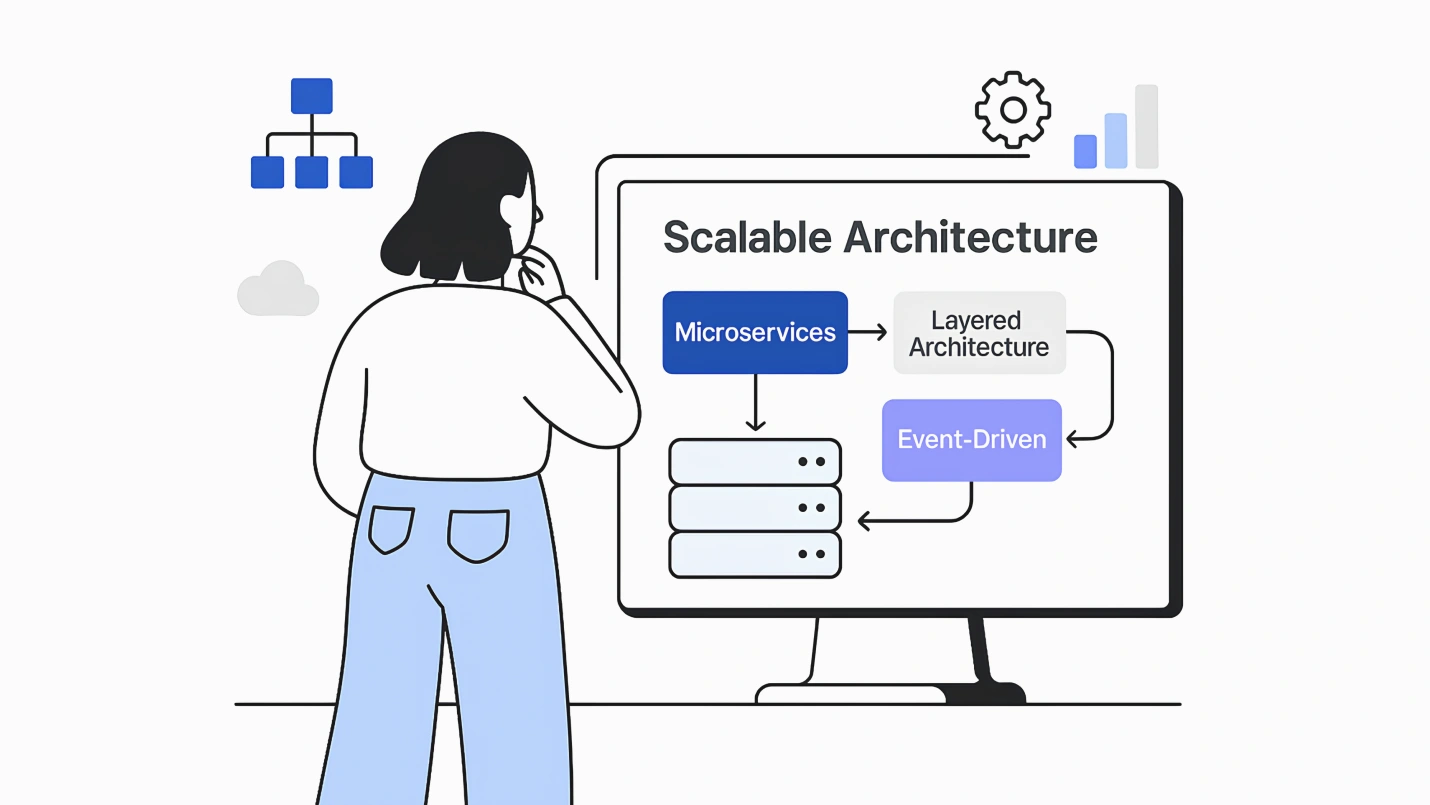Good software architecture helps maintain the software’s quality attributes throughout its lifetime, making it easier to scale & evolve the software over time. Learn what software architecture is, why it matters, and what practices you must follow to design secure, scalable, and reliable software.
The software development process is similar to building a dream house. If the foundation is strong, it will stand the test of time and serve the customer’s needs across its lifetime. On the other hand, software without a strong foundation crumbles faster than a house of cards. Software architecture ensures the software has a robust foundation and is precisely what the customer wants.
Let’s continue with the analogy.
When building a house, some decisions need to be made early in the process. These decisions include the materials used, house design, internal architecture, etc. These decisions define the house’s longevity, strength, and quality. Moreover, building new floors on top with a firmly laid foundation becomes easy.
Similarly, software architecture makes decisions regarding essential parameters defining the software’s internal quality in the long run. It happens early in the software development cycle (following the requirements analysis) because further development would depend on it.
This write-up discusses software architecture in detail.

We respect your privacy. Your information is safe.
What is Software Architecture?
“In most successful software projects, the expert developers working on that project have a shared understanding of the system design. This shared understanding is called architecture.” — Martin Fowler
Software architecture is the high-level design and organization of software in which we make important decisions regarding its overall structure, such as the relationships between components, data flow patterns, and the mechanism for communication between different parts of the system.
Software architecture typically involves:
- Defining the software’s fundamental abstractions, modules, and interfaces.
- Establishing guidelines and principles to ensure that the system is designed to meet its functional and non-functional requirements.
A good software architecture helps define performance, quality, scalability, maintainability, manageability, and usability. The goal is to ensure that your software is flexible, extensible, and can evolve as new requirements emerge.
It is imperative to think through software architecture for effective development methodically. This way, you can easily develop, test, deploy, and maintain the software, while minimizing the risk of errors, bugs, and other problems arising during the software development lifecycle.
Software Architecture Example
The Model-View-Controller (MVC) pattern is an example of a software architecture widely used for developing user interfaces in web and desktop applications. In this pattern, we divide the software system into the following three components:
- Model represents the data and business logic of the system. It interacts with the database, processes data, and performs calculations.
- View represents the user interface of the system. It displays data to the user and receives input from them. The view is typically implemented using HTML, CSS, and JavaScript.
- Controller manages the interactions between the model and the view. It receives user input from the view, processes it, and updates the model accordingly. The controller also updates the view to reflect changes in the model.
The upside of the MVC pattern is that it separates all the components of a software system, making it easier to maintain, test, and extend the software. Changes to the user interface do not affect the model or the controller, and vice versa. Also, you can easily modify and enhance the system without introducing bugs or unexpected behavior.
MVC pattern is an excellent example of how software development architecture lays out a high-level system structure, which acts as a blueprint for software development and ensures that the system meets its functional and non-functional requirements.
Why is Software Architecture Important?
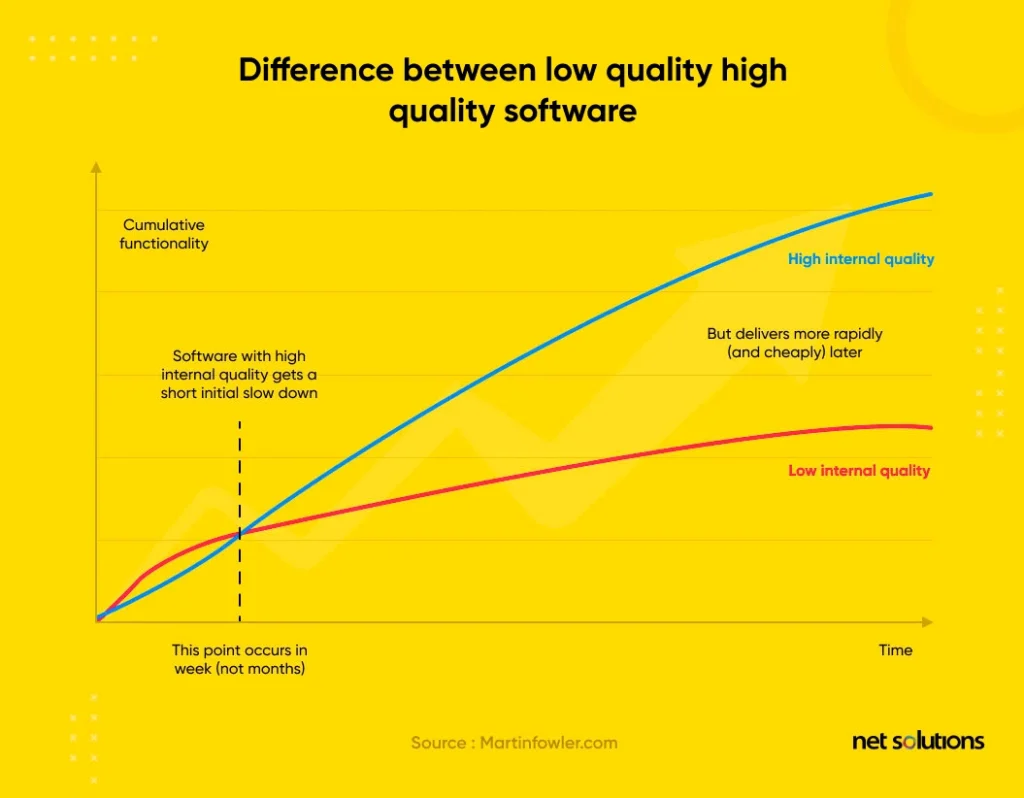
An organized software architecture helps to ensure the longevity of the software’s internal quality.
Let’s understand with the help of an example:
Suppose you have two similar products that you launched within three months gap. There are two scenarios:
- You launched Product A in Jan 2021. It supports a messy source code because the development team wanted to launch and monopolize the market as early as possible.
- You launched Product B in March 2021. It has a well-structured and organized software architecture. The development team worked on the design and architectural decisions early in the process, prioritizing quality over a faster launch.
Which Product will be more successful: A or B?
Product A might monopolize the market initially and convert better. However, product adoption will eventually subside because the messy code will lead to technical debt pileups. These pileups will, in turn, make it challenging to introduce new updates and bug fixes on the fly.
On the other hand, Product B might have a market entry gap, but it will be easier to maintain a faster shipping cadence. The customer needs will be looked after without breaking the shipping cadence, thus making for a larger win.
That is why the architecture in software engineering matters. It ensures you release high-quality software while maintaining a faster shipping cadence.
Software Architecture Principles: S.O.L.I.D.
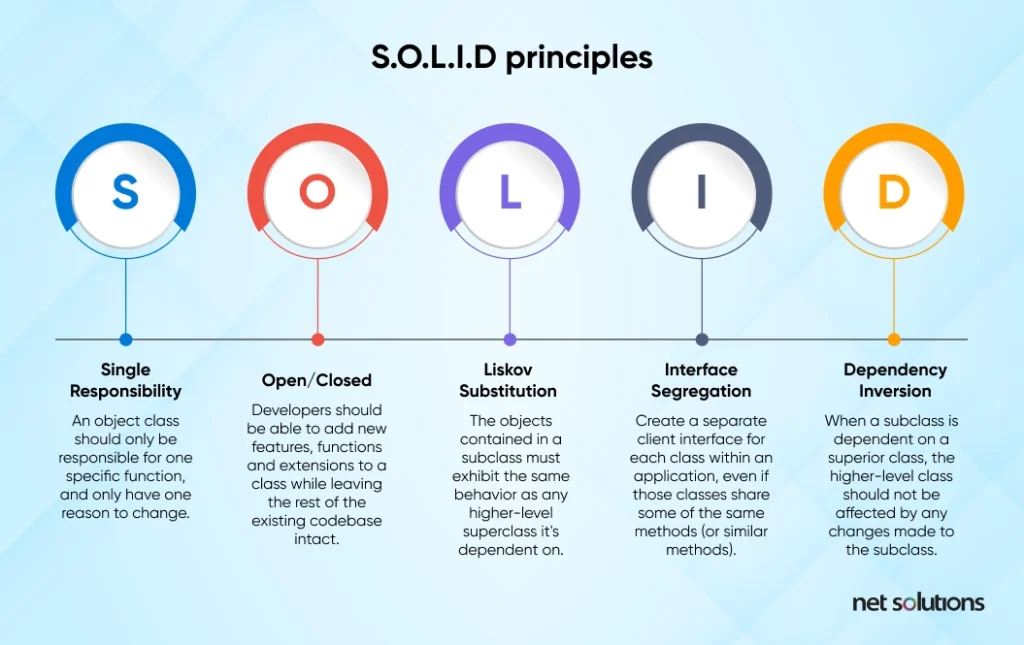
The software architecture must adhere to the S.O.L.I.D. principles of architectural design in software engineering, including
1. Single-Responsibility Principle
The single-responsibility principle states that each class should have only one responsibility. The idea is to encourage developers to create smaller, focused classes that are easier to test and maintain.
2. Open-Closed Principle
According to the open-closed principle of software architecture, you should be able to add new functionality to a class without changing its existing code. The goal is to encourage using interfaces and abstract classes to create flexible, extensible systems.
3. Liskov Substitution Principle
According to the Liskov Substitution Principle, the subclasses should be substitutable for the base classes. You should be able to use a subclass instead of its parent class without causing errors or unexpected behavior. This principle encourages the creation of hierarchical class structures that are easy to reason about.
4. Interface Segregation Principle
The interface segregation principle states that all user interfaces should be separate. Also, it is a good practice to have many intent-driven interfaces over one general-purpose interface. The purpose of this principle is to encourage the creation of cohesive, focused interfaces that are easier to use and maintain.
5. Dependency Inversion Principle
According to the dependency inversion principle, the modules should depend on the interfaces or abstract classes, not the concrete classes and functions. This principle encourages using interfaces and abstract classes to create loosely coupled, flexible systems.
Good Software Architecture Characteristics
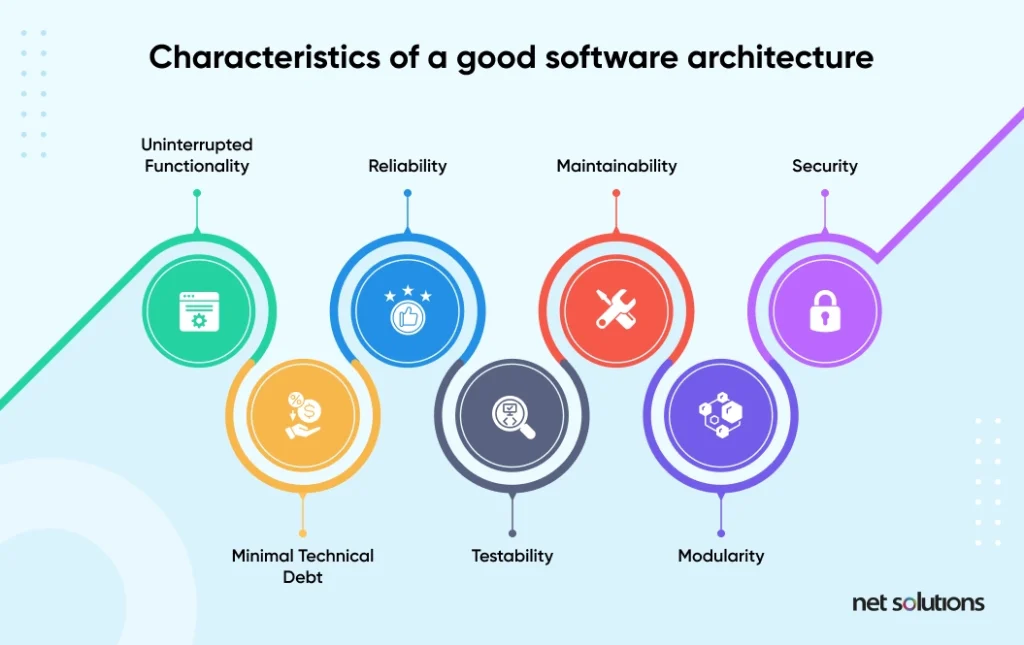
The noteworthy characteristics of software architecture include the following:
- Uninterrupted Functionality: The software system should perform as intended without any bugs or interruptions.
- Reliability: The software system should perform optimally, irrespective of the environment and input number.
- Maintainability: Your team should be able to introduce innovative changes to the software without interrupting the existing system’s functionality.
- Security: The software should be secure from all external or internal attacks.
- Minimal Technical Debt: The source code should be clean and organized rather than messy or full of anti-patterns. This reduces the code refactoring efforts and corresponding technical debt.
- Testability: You should seamlessly conduct software testing for faster bug identification, thus reducing the time to market.
- Modularity: You should be able to divide the software system into smaller, more manageable modules. It proves helpful when introducing microservices architecture when scaling up operations.
Popular Software Architectural Patterns
A software architecture pattern is a reusable solution that helps design software architecture for commonly occurring problems.
Software architecture patterns provide a way to capture design structures that have performed well with the intent of reusing them. Building an architecture involves selecting, tailoring, and combining patterns.
As per a book by Mark Richards, there are five major software architecture patterns to consider utilizing throughout the design process: microkernel, microservices, layered software architecture, event-based, and space-based.
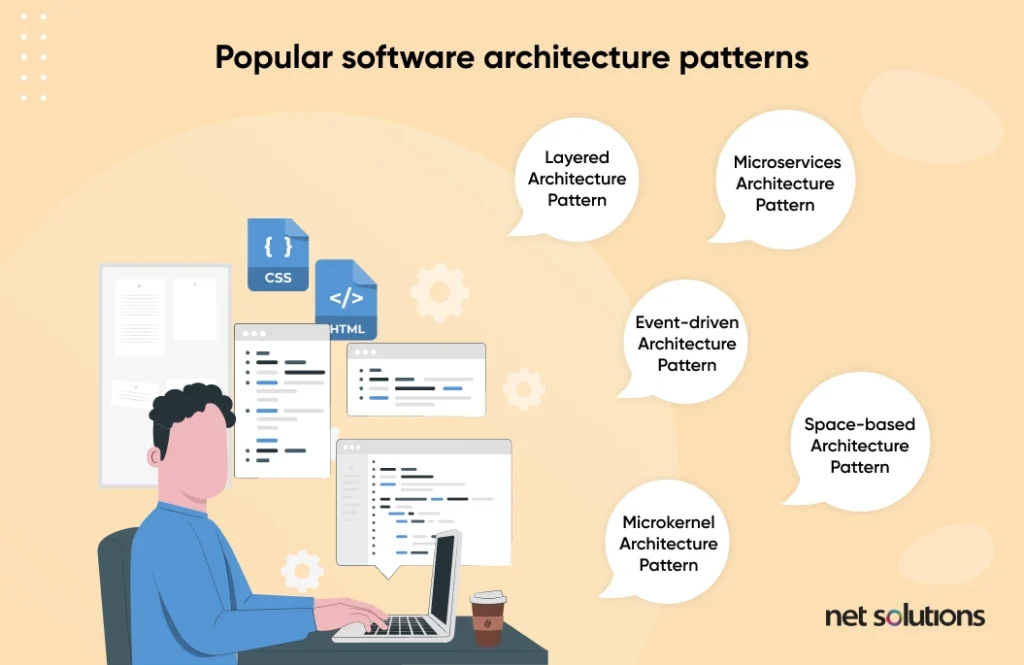
1. Layered Architecture Pattern
As the name depicts, the layered software architecture utilizes a tiered approach where one layer offers services to the higher layer. This layered approach is popular within the software industry because it is simple to develop and maintain. In the layered architecture pattern, all the components are interconnected and don’t depend on each other.
MVC (Model-view-controller) pattern is a typical example of a layered architecture pattern that employs a three-layer approach.
When to choose a layered architecture pattern?
- Time is limited, and developers need to build an app quickly
- Apps that require strict maintainability and testability standards
- Business apps that need to embrace traditional IT structures
2. Event-driven Architecture Pattern
Unlike the layered software architecture pattern, an event-driven architecture pattern is a modern approach that centers around “event” data. This pattern enables the app modules to act on defined events when they occur. It includes single-purpose event-processing components that listen to and process events asynchronously. These patterns comprise two categories: broker topology and mediator topology.
When to choose an event-driven architecture pattern?
- You’re developing complex apps that demand seamless data flow
- You’re building user interfaces
- You’re building apps that have asynchronous data flow systems
3. Microkernel Architecture Pattern
The microkernel architecture pattern is also called the plugin architecture pattern. This architecture pattern is utilized when software teams build systems with interchangeable components. This pattern is ideal for applications that require sufficient flexibility to adapt to the evolving system requirements. The microkernel architecture pattern is divided into two segments:
- Minimal functional core: The system includes general business logic without custom code for complex conditional processes.
- Extended functionalities: Independent components called plugins support the core by offering specialized processing and additional features through custom code.
When to choose a microkernel architecture pattern?
- You’re building workflow-oriented applications.
- You’re building apps that need separation between low-level functionalities and higher-level functionalities.
- You’re building task & job scheduling applications.
- You’re developing enterprise apps as this pattern offers scalability, extensibility, and portability.
4. Microservices Architecture Pattern
The microservices architectural pattern is a modular software architecture example. It follows the development of small independent apps that communicate with each other so the entire system works seamlessly.
This pattern enables developers to deploy the apps independently while offering a high degree of application and component decoupling within the app. Since microservices communicate, the developers must ensure that the messages sent across them persist in being backward-compatible.
When to choose a microservices architecture pattern?
- You’re managing multiple corporate data centers with well-defined boundaries.
- You’re building apps with immense and rapidly growing data systems
- You’re developing new businesses and web applications quickly.
- You’re re-writing monolithic applications to a more sustainable pattern.
- You’re building Websites with small components.
5. Space-based Architecture Pattern
The space-based architecture pattern is popular for its ability to address scalability and concurrency issues. This pattern is also helpful for apps with variable and unpredictable concurrent user volumes. This pattern is based on the concept of tuple space.
According to Wikipedia, a tuple space implements the associative memory paradigm for parallel/distributed computing. Tuple space provides a repository of tuples that can be accessed concurrently.
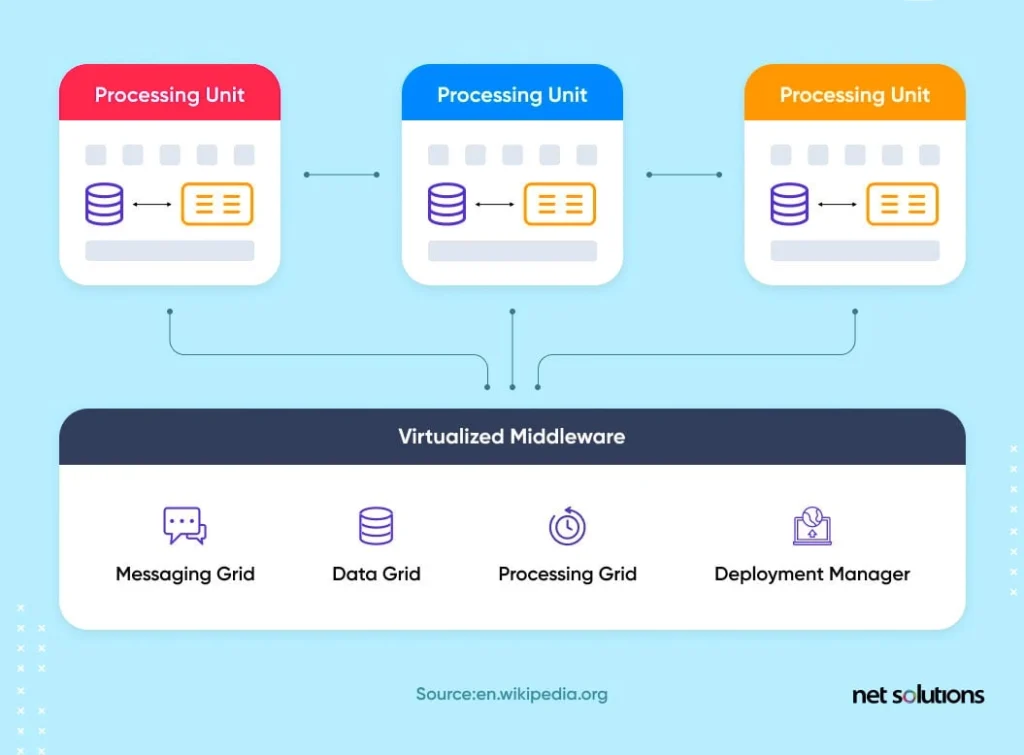
In this figure, the processing unit component includes both web-based components and backend business logic. Smaller web apps can be deployed in a single unit, while larger apps are fragmented into multiple processing units.
The virtualized-middleware component includes elements responsible for data synchronization and controlling handle requests. There is no central database throughout the space-based architecture pattern.
When to choose a space-based architecture pattern?
- You’re building eCommerce or social websites.
- The apps you build manage high-volume data like clickstreams and user logs.
- You’re building apps that address scalability and concurrency issues.
What Are The Best Tools for Software Architecture Design?
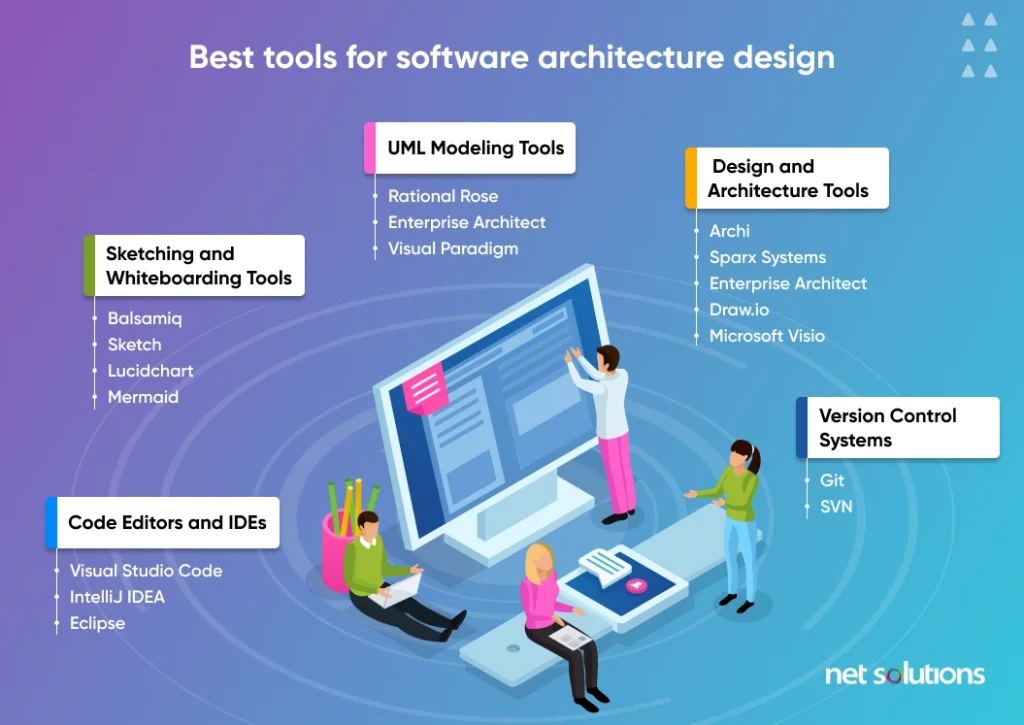
Here are some of the best software for software architecture:
1. UML Modeling Tools
Unified Modeling Language (UML) is a standard visual modeling language used to design software systems. It consists of a set of diagrams representing different system aspects.
With UML modeling tools, users can create and edit UML diagrams. They offer a wide range of features, such as drag-and-drop functionality for adding objects to diagrams, automatic layout tools for arranging objects, and validation tools to ensure diagrams conform to UML standards.
Here are some of the most popular UML modeling tools:
- Rational Rose
- Enterprise Architect
- Visual Paradigm
2. Sketching and Whiteboarding Tools
Sketching and whiteboarding tools are software architecture diagram tools for quickly creating sketches and diagrams of software architectures. These tools are handy for brainstorming and exploring different design ideas.
Here are some Sketching and Whiteboarding tools:
- Balsamiq
- Sketch
- Lucidchart
- Mermaid
3. Code Editors and IDEs
Code editors and integrated development environments (IDEs) can create and edit code and offer to debug, refactoring, and code analysis features.
Some popular code editors and IDEs:
- Visual Studio Code
- IntelliJ IDEA
- Eclipse
3. Design and Architecture Tools
Design and architecture tools are designed to create the best software architecture diagrams. Here are a few tools for software architecture design:
- Archi
- Sparx Systems
- Enterprise Architect
- Draw.io
- Microsoft Visio
4. Version Control Systems
Version control systems are essential for managing changes to software architecture designs over time. They allow architects to track changes, collaborate with others, and roll back changes when needed.
Popular version control systems are:
- Git
- SVN
Best Software Architecture Practices
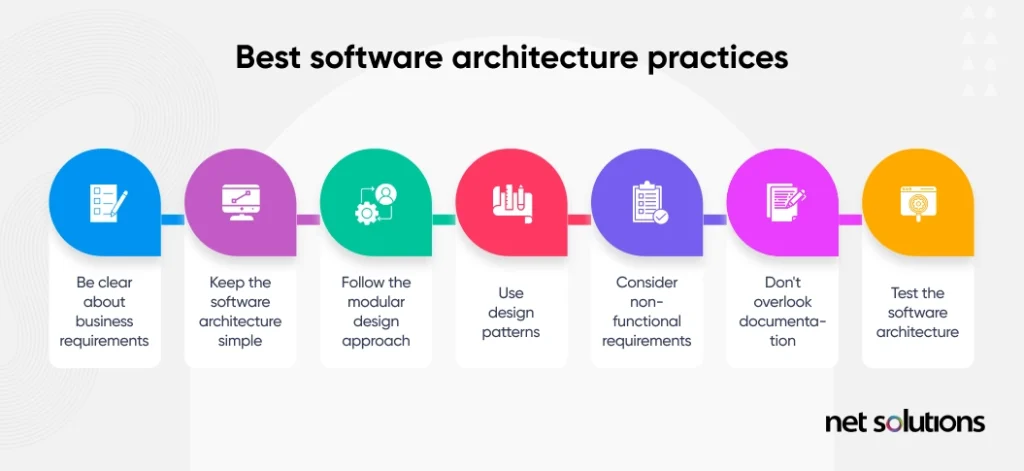
Here are the software architecture best practices that software architects must follow to design scalable, maintainable, and reliable software system that meets your organization’s needs:
- Be clear about the business requirements of the software system before you start working on its design. It would ensure that the software meets stakeholders’ business goals and is what you had expected.
- Keep your software architecture simple, as managing and scaling it will be easier over time. Steer clear of any complexity or layer that may complicate things later.
- Follow the modular design practice (breaking down an extensive system into small modules) while laying out the architecture of your software system. They’re easier to scale, maintain, and reuse.
- Use design patterns in your software architecture as they offer a standardized approach to solving problems, letting you easily maintain and scale the software system.
- While considering functional requirements is essential, you must also consider non-functional requirements like performance, security, and reliability. Addressing them early in the design process would ensure you meet all the requirements.
- Don’t overlook documentation can help you communicate design decisions to stakeholders and fix issues, ensuring that design designs are understandable and maintainable over time.
- Test the software architecture early and often to ensure the software meets both the functional and non-functional requirements.
Frequently Asked Questions
The gap between the actual and the real software architecture is called software architecture erosion.
Software architecture recovery is the process of bringing forth the software architecture of an existing system using software analysis and available documentation..
Here’s what makes software architecture so difficult:
- Legacy software redesigning
- Handling software integrations early in the process
- Aligning software architecture with the Agile development goals
- Unavailability of accurate software architecture automation tools
- Poorly managed communication among various stakeholders
Both software architects and software engineers are part of the software development process. However, both focus on different areas. Software engineers handle software application design, development, testing, and maintenance. They work with programming languages and tools to write code, debug and test software, and deploy applications.
On the other hand, software architects focus on software systems’ high-level design and overall structure. They work with stakeholders to understand business requirements and design software solutions. They create architecture diagrams, define software interfaces, and decide technology stacks and development methodologies.

